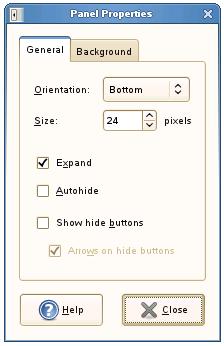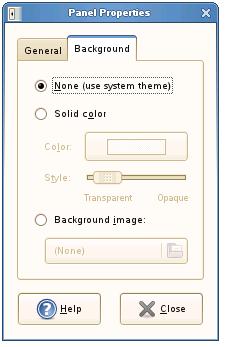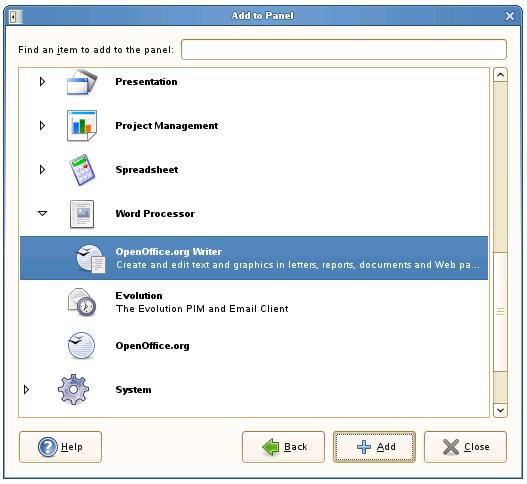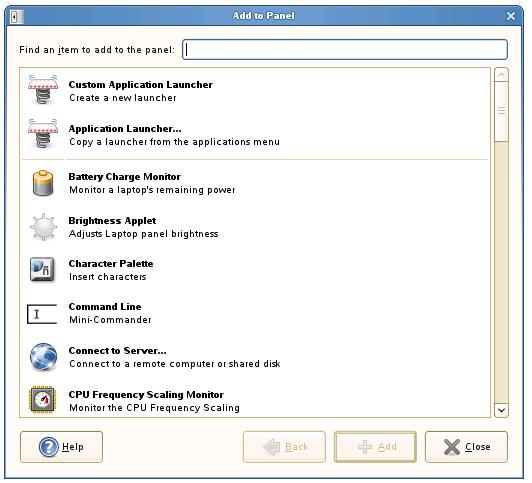Configuring the openSUSE Desktop Panels
| Previous | Table of Contents | Next |
| Configuring openSUSE Desktop Fonts | Configuring openSUSE Workspaces |
The openSUSE GNOME Desktop Panels are probably the most useful aspect of the entire desktop simply because they provide quick access to a wide variety of functionality. As with just about every other aspect of the GNOME desktop, these panels are accompanied by extensive configuration options. In this chapter of openSUSE Desktop Essentials we will look at each of these configuration in detail.
What are Desktop Panels
On a newly installed openSUSE system there are a single panel is configured by default. This panel appears across the bottom of the desktop area:
The openSUSE desktop panels can be configured in a variety of ways including:
- Adding additional panels to the desktop
- Moving the panels to different locations on the desktop
- Adding mini applications (such as stock ticker or weather applet) to a panel
- Size, background, visibility and transparency of panels
In the remainder of this chapter we will look at each of these customization options in detail.
Changing the Position of a Panel
A panel can be placed in one of four different locations on the desktop: the top, bottom, far left or far right of the desktop. There are two ways to change the position of a openSUSE GNOME Desktop panel. By far the easiest method is to simply click with the left hand mouse button on the panel you wish to relocate and drag it to the new location. before this can be done, however, the panel must be first be unlocked. To do so, simply click with the right hand mouse button on any blank area of the panel and select Allow Panel to be Moved from the resulting popup menu. The panel may then be dragged to a new location. To avoid inadvertently moving the panel in future right click again on the panel and select Lock Panel Position.
Alternatively, the location of the panel can be adjusted using the Properties dialog of the panel. This dialog is accessed by clicking with the right hand mouse button on any blank area of the panel and selecting Properties from the popup menu:

From the Panel Properties dialog, change the Orientation setting to the desired value to position the panel as required.
Adding and Deleting Desktop Panels
New panels may be added to the desktop by right clicking on any existing panel and selecting New Panel from the resulting menu. The new panel will be placed in an orientation where no panel currently exists. If you already have panels on all four sides of your desktop, the new panel will be placed next to a pre-existing panel. It is possible to fill your entire desktop with panels if you wish, though obviously this is not recommended.
An existing panel may be removed from the desktop by right clicking on the panel and selecting Delete This Panel from the popup menu.
Changing the Appearance of a Desktop Panel
A number of configuration options are available for changing the appearance of each desktop panel. These changes are implemented using the Panel Properties dialog (accessed by right clicking on the panel to be changed and selecting Properties from the popup menu).
The Size property controls the height (when the panel is in a horizontal orientation) or width (when in vertical orientation). It is not possible to reduce the size to the extent where items will no long be visible (the minimum value is typically around 23 pixels).
A different color or even an image may be specified for the panel background. These settings are available from the Background page of the panel properties dialog:
The level of transparency can be specified by adjusting the Style slider which becomes active after Solid Color is selected.
The panel may be further configured so that it remains hidden until the mouse pointer moves to the side of the desktop where the panel is located. To activate this feature, select the Autohide option on the main panel properties page.
Finally, if you do not wish to have the panel occupy the full width or height of the desktop (depending on the orientation of the selected panel), unset the Expand option. The panel will then only appear as wide or as tall as it needs to be to accommodate the items it is configured to display.
Adding Items to a GNOME Desktop Panel
When openSUSE Linux is first installed, a number of items are added by default to the two panels. Additional items, however, may easily be added to any panel. If, for example, there is an application you frequently launch from the Applications menu there is a quick way to add a launch icon to the panel. Simply launch the Add to Panel dialog by right clicking on a blank area of the desired panel, selecting Add to Panle and click on the Application Launcher option in the resulting dialog. The resulting dialog will list a range of application categories each menu item and all sub-menu items. If, for example, you wanted to be able to launch the OpenOffice Writer word processor from the panel simply click on the arrow next to Office in the Add to Panel dialog to unfold the list of Office categories. Then click on the Work Processor category, select OpenOffice Writer and click on the Add button:
In addition to applications from menus, it is also possible to add a range of items specifically designed to appear on panels. To add such items to a panel click with the right mouse button over the panel to be configured and select the Add to Panel menu option from the resulting popup menu. The Add to Panel dialog will then appear as follows:
To add an item to the panel, simply scroll through the list provided, select the required item and press the Add button. The following panel shows an example openSUSE desktop panel with transparency enabled and the system monitor and weather items added:
To edit the properties or preferences for a panel item, move the mouse pointer over the item in the panel and click the right mouse button. Select either Properties or Preferences from the menu and the appropriate dialog will appear. For example, the Preferences panel for the Weather item allows various settings to be changed, such as the geographical location and units for displaying temperature (Celsius or Fahrenheit). The system monitor can similarly be configured to also display metrics such as system load, memory and network usage.
To delete an item from a panel right click with the mouse on the item and select Remove from Panel.
To move an item to a different location in a panel right click with the mouse on the item and select Move. Then use the mouse to drag and drop the item to a new location. Alternatively, click with either the middle mouse button, or the left and right mouse buttons and drag and drop the panel item to the new location.
To add an application not currently available from the desktop menus simply select the Custom Application Launcher and specify the path to the application executable and provide a name. Click on the No icon button to select an icon to represent the item on the panel.
In the next chapter we will look at adding more virtual workspaces to the openSUSE desktop and cover the steps to add a Workspace Switcher item to the desktop panel.
| Previous | Table of Contents | Next |
| Configuring openSUSE Desktop Fonts | Configuring openSUSE Workspaces |



